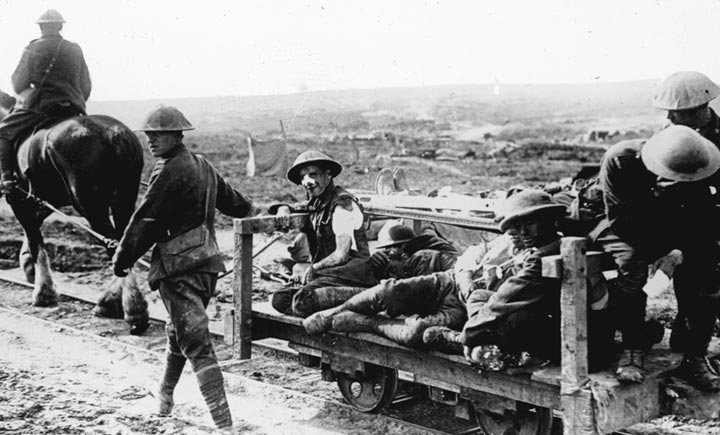MB367/148845, Victoria League of New Zealand Records, Wounded Canadian soldiers being taken from the front line to a dressing station on a horse-drawn light railway truck.( Lt. William Ivor Castle; Flers-Courcelette, Somme, France; September, 1916).

Wounded Canadian soldiers

MB367/148845, Victoria League of New Zealand Records, Wounded Canadian soldiers being taken from the front line to a dressing station on a horse-drawn light railway truck.( Lt. William Ivor Castle; Flers-Courcelette, Somme, France; September, 1916).
Symbols of British strength and success were relatively straightforward in their propaganda worth. Images of the more negative aspects of war were more problematic, but still useful to propagandists.
This image, by Canadian official photographer Lt. William Ivor Castle, of wounded Canadian soldiers being taken from the front lines of the Battle of Flers-Courcelette, to a dressing station by a horse-drawn light railway truck, reflects some of the contradictions and controversies surrounding photographs of wounded soldiers. Photographs of casualties were some of the most controversial of the war, due to their varied impacts and contradictions. This image reflects this conflict well. Photographs of wounded soldiers could be viewed in a positive light. Images of smiling wounded soldiers, such as the soldier third from left, with the nose bandage, enduring their wounds with cheerfulness were often used as examples of Allied determination and perseverance. Such examples of resilience were important later in the war, when war weariness set in. However, images of casualties also reinforced negative sentiments regarding the war. Such photographs were a visual representation of Allied setbacks, in this case only highlighting the terrible losses suffered in the early stages of the Battle of the Somme. Furthermore, images of wounded soldiers with more negative emotions, such as the soldier at the far right of the image, only emphasised the suffering and trauma caused by the war. British propagandists were aware of this conflict, as photographs of casualties were largely held back during the early stages of the war. This photograph is also notable for its strongly Canadian focus. While the first official photographers on the Western Front were British, other imperial nations soon followed suit, with Canada quickly enlisting Castle. These national photographers were charged with documenting specifically national achievements in the war. Therefore, this image of Canadian troops during the Battle of Flers-Courcelette, in which the Canadian and New Zealand Divisions made their debut in the Battle of the Somme, reflects this emerging national focus in First World War photography.